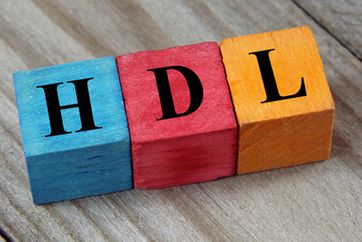'Good' cholesterol exhibits shortcomings as indicator of CV health
A study of the relationship between HDL cholesterol levels and risk for myocardial infarction and death revealed limitations in using HDL-C level as an indicator of health. Although HDL-C has been characterized as “good” cholesterol, the optimal levels are more complicated than has been assumed, according to Marc Allard-Ratick, MD, a hospitalist at Emory University School of Medicine.
Increased risk at high levels
Allard-Ratick and colleagues analyzed data from 5,965 adults, most of whom had heart disease, as part of the Emory Cardiovascular Biobank. The average age of participants was 63 years, and 35% were women.
Researchers found that risks for all-cause mortality, CV mortality and nonfatal MI were elevated among participants with HDL-C levels lower than 30 mg/dL and also among patients with levels above 60 mg/dL. Patients with the lowest risk had “normal” HDL-C levels between 40 mg/dL and 60 mg/dL, Allard-Ratick told Endocrine Today.

This relationship was consistent after controlling for other heart disease risk factors, including diabetes, smoking and LDL cholesterol, as well as factors linked to high HDL-C, including alcohol intake, race and sex.
Publication of the full study is forthcoming, and findings were shared via a press release and at the European Society of Cardiology Congress in August.
Although more research is needed, Allard-Ratick said, the findings show that the impact of HDL is not as straightforward as that of LDL.
A multifaceted role
HDL “is well-known for playing a key role in reverse cholesterol transport. Thus, it is believed that the HDL molecule is important for the reduction of atherosclerosis,” Allard-Ratick said.
Because patients with diabetes are already at increased risk for atherosclerosis and CV events, physicians know to ensure these patients’ HDL-C levels are not too low.
“There are multiple reasons [HDL] is looked at as protective,” James A. Underberg, MS, MD, FACPM, FASPC, FASH, FNLA, clinical assistant professor of medicine at NYU School of Medicine and NYU Center for Prevention of Cardiovascular Disease and director of Bellevue Hospital Lipid Clinic, told Endocrine Today.
HDL “has a protective effect on inflammation and on oxidation. It helps maintain the integrity of the vascular endothelium,” Underberg said.
To determine HDL-C level, most physicians measure the amount of cholesterol contained in the HDL particle, but do not examine the molecule itself. Although this is the best available tool for measurement, Allard-Ratick and Underberg said they believe that it falls short of determining the full impact of HDL.
“This has left us unsure of the role HDL plays as a marker for cardiovascular health, despite the fact that it is heavily involved in many crucial processes within the body,” Allard-Ratick said.
Underberg noted that HDL-C levels are not an indicator of the function of the molecule and have not been linked to any of the protective processes that have led to HDL-C becoming known as “good” cholesterol.
“Our measurement of HDL-C might be too simple, and instead we may need to measure other aspects of the HDL molecule to get a clearer picture of a patient’s cardiovascular health. This all remains unclear, and more research is needed,” Allard-Ratick said.
“The more I learn about HDL, the less I know,” Underberg said.
Looking beyond HDL
Underberg said our current understanding of HDL and HDL-C does not yet have implications for individual patients. He suggested technology could lead to an HDL index tool providing a composite view of its many facets, but “for an individual right now, we just do not know.”
Allard-Ratick agreed that the findings should not change patient management practices. For the time being, he said LDL-C remains a much better marker for CV risk, as the use of medication to lower LDL-C leads to a reduction in CV events.
“At this time, the association between very high HDL-C and adverse outcomes is just a correlation, and there is no evidence that lowering HDL-C in these patients leads to improved outcomes,” he said. “Until we have this type of evidence, our management of these patients should be like all others at risk for cardiovascular disease and should focus on improving other modifiable risk factors, such as high blood pressure, high LDL-C, diabetes, obesity and smoking.” – by Amanda Alexander
Reference:
Allard-Ratick M. HDL cholesterol — A moving target. Presented at: European Society of Cardiology Congress; Aug. 25-29, 2018; Munich.
For more information:
Marc Allard-Ratick, MD, can be reached at mallard@emory.edu.
James A. Underberg , MS, MD, FACPM, FASPC, FASH, FNLA, can be reached at james.underberg@nyumc.org.
Disclosures: Underberg reports he is on the scientific advisory board for the FH Foundation, a consultant for Amgen and a member of the speakers bureau for Amgen, Regeneron and Sanofi. Allard-Ratick reports no relevant financial disclosures.
